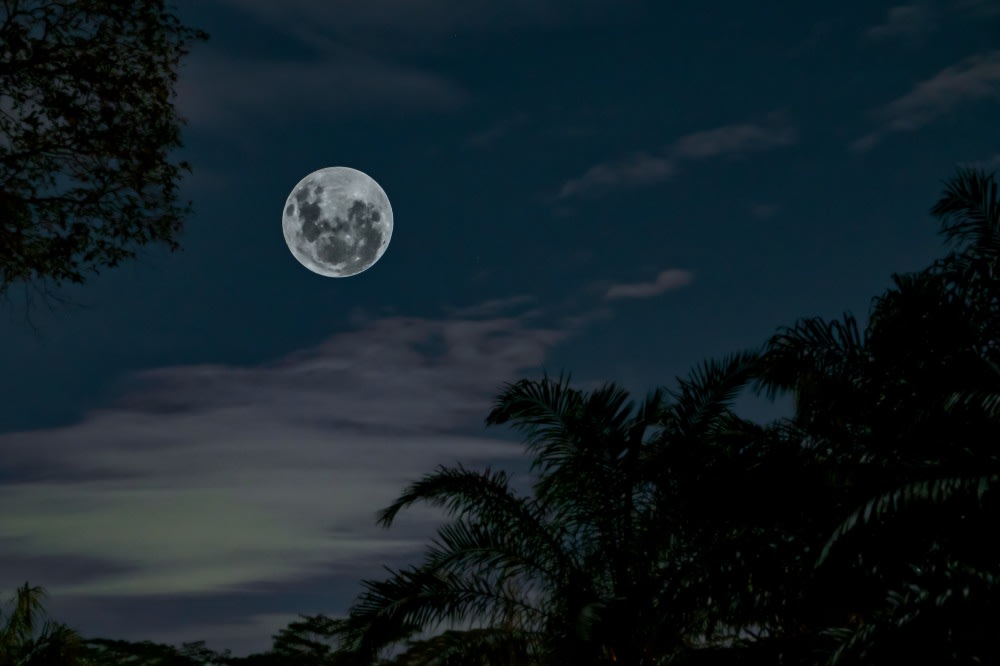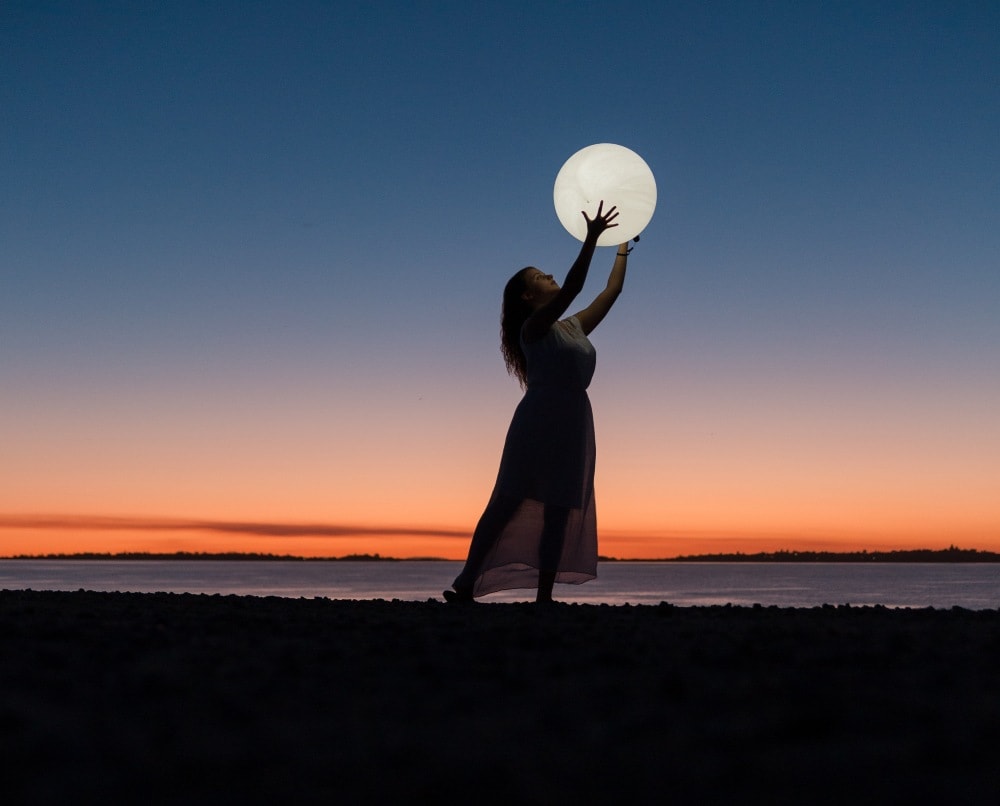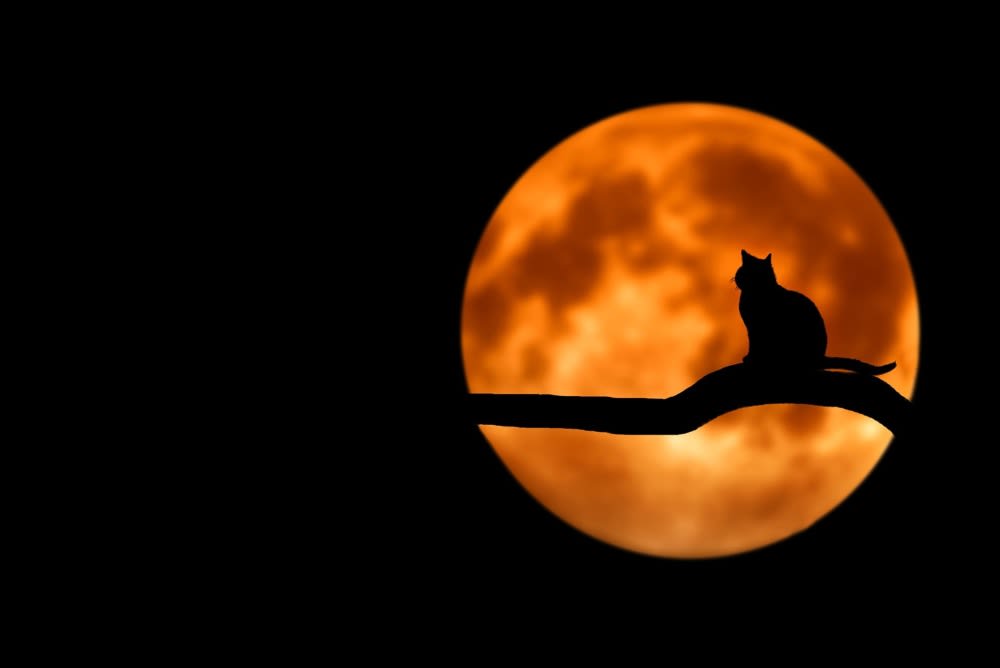What kinds of full Moon do exist?
Full Moon in January: Wolf Moon

In January, Full Moon is called Wolf Moon, and Native Americans obviously had a strong reason to name it this way. January is the month when wolves suffered from winter hunger, came out of forests, and approached the villages starting to howl and scare people. Names used by other tribes for the Full Moon in January are the Old Moon, the Moon after Yule, and the Snow Moon, as January and February are typically the snowiest winter months. But the Snow Moon is now more frequently applied to February Full Moon, because this month holds the title of the coldest, windiest, and snowiest time of the year.
Full Moon in February: Snow Moon
In February, the Full Moon is most often called the Snow Moon, because the heaviest snowfalls generally occur during this winter month. Another interesting name for this Full Moon is the Hunger Moon, and it was given to February Full Moon by some Native American tribes because hunting in this period became extremely difficult, and people had to stint themselves in food to see the coming of spring. Other tribes called this Moon the Shoulder to Shoulder around the Fire Moon and the Bone Moon, which also meant that February gave so little food to people that they had to gnaw on bones and eat bone soup.
Full Moon in March: Worm Moon
In March, Full Moon is traditionally called the Worm Moon, and this seemingly strange name is easily explained. The thing is that in spring it starts getting warmer, the earth becomes softer, and lots of earthworms start to reappear after the long cold winter. The return of earthworms causes the return of birds, particularly robins, and this becomes the brightest sign of the forthcoming spring warmth. Some Native American tribes call March Full Moon the Sap Moon, as in this month maple sap starts to flow, and marks the time of annual maple trees tapping.
Full Moon in April: Pink Moon

In April, Full Moon is called the Pink Moon, and this name is explained not by the color of the Moon itself, but by the color of the earliest flowers that start blooming in April. The Grass Moon is another title that was given by Native Americans to the Full Moon of this spring month. It also marks the wonderful period of moss pink appearance, when everything around you is covered with a fantastic pink carpet of flowers. This Full Moon is also known among coastal tribes as the Egg Moon or the Fish Moon, when fish come upstream to spawn, and the new fishing time begins.
Full Moon in May: Flower Moon
The Full Moon in May has a beautiful name of the Flower Moon, although some Native American tribes called it the Corn Planting Moon, the Milk Moon, the Hare Moon or the Mother’s Moon. May is usually abundant in flowers, so such a name given to the Full Moon that appears this month is quite appropriate. Another interesting peculiarity connected with May Full Moon is a unique astronomical phenomenon that took place in 2016. In spring, we were able to observe four Full Moons instead of three, and this third “additional” May Full Moon got the name “the Blue Moon.”
Full Moon in June: Strawberry Moon
In June the Full Moon is for obvious reasons called the Strawberry Moon, as in this month women and children of Native American tribes hurried to forests and meadows to gather ripening strawberries and enjoy this delectable fruit. In Europe, where these berries aren’t native, June Full Moon is known as the Full Rose moon, because this month marks the early bloom of roses and other summer flowers. As June is the first summer month that designates the beginning of summer heat and the time when nectar flow ends, some Native American tribes called the Full Moon in June the Hot Moon or the Honey Moon.
Full Moon in July: Thunder Moon

The Full Moon that you see in the sky in July is called “Full Buck Moon,” as July is the time when buck deer start growing new antlers. Summer weather with its frequent thunderstorms prompted another apt name –the Thunder Moon. One more speaking name – the Hay Moon – reflects the typical agricultural activity of the month. In 2016, the best days for cutting hay are July 24 to 26. But if you have nothing to do with scythes and sheaves, consider going fishing from July 4 through 19 – your catch is sure to be quite impressive!
Full Moon in August: Sturgeon Moon
Native American tribes noticed that sturgeon fishing in the Great Lakes and Lake Chaplain was most easy and effective in the month of August, hence the associative name they invented for the August Full Moon – the Sturgeon Moon. In 2016, the luckiest time period for fishing will be August 2 through 18. However, other tribes had alternative names for the Full Moon they saw in the August sky: the Green Corn Moon, the Red Moon, the Grain Moon, the Wheat Cut Moon, the Moon When All Things Ripen, or the Blueberry Moon.
This year, the Full Moon will appear in the night sky on August 18. But if you set your alarm clock to 1:00 AM (ET) a week earlier, on August 11, 2016, you may be lucky to enjoy a truly spectacular cosmic show – the Perseid meteor shower!
Full Moon in September: Harvest Moon
The Full Moon that is seen in the sky on a night closest to the Fall Equinox is associated with the time when Native Americans harvested corn, so they named it appropriately – the Harvest Moon or the Corn Moon. Some tribes harvested barley in September, too, so they called their Full Moon the Barley Moon. It shone so bright that people could stay in the fields longer and finish every harvesting chore in time. Other Native American tribes offered more poetic names for September Full Moon like the Moon When the Plums Are Scarlet, the Moon When the Deer Paw the Earth, or the Moon When the Calves Grow Hair. These are beautiful examples of natural changes reflected in the language of people who lived in harmony with nature!
In 2016, if you look into the sky on a night of September 29, you’ll see a bright spot right above the crescent Moon – this would be Mercury, the shiny morning ‘star.’ And if you are into farming or gardening, try to harvest your crops in appropriate time periods: September 1 and 2 for above ground cultures and 19-20, 28-29 for below ground ones.
Full Moon in October: Hunter’s Moon

Since October proved to be the most successful hunting month for Native Americans, they used the time to make provisions for the future. Game caught at that time was well-fed and fat enough to keep them through the long winter months that lay ahead. It seems quite logical that they gave the Full Moon that appeared in October the name of the Hunter’s Moon. However, if it falls closest to the Fall Equinox, October Moon is called the Harvest Moon. Other alternative names include the Travel Moon or the Dying Grass Moon.
There are folklore beliefs connected to the Full Moon. Babies born on a day after the Full Moon will have success accompany them throughout the whole life. Quite the opposite, a piece of clothing washed for the first time when the moon is full will not last for long.
Full Moon in November: Beaver Moon
The Full Moon that appears in the sky in November is known by Native Americans as the Beaver Moon. There are two equally possible origins of the name: Native American set beaver traps in November, before pools of water started freezing, to ensure that they get enough fur to ward off winter colds. Beavers themselves started their own preparations for winter around the same time. An alternative November Full Moon name is the Frosty Moon.
In 2016, the Beaver Moon will appear on November 14, and will be a truly spectacular sight: a Supermoon that will be closer to Earth than it has been in almost 70 years! It is expected to produce a very noticeable influence on tides and people.
Full Moon in December: Cold Moon
In December, winter weather takes hold of the main part of the US, and the nearing Winter Solstice makes nights longer and darker. Native Americans calcified both facts in the names they offered for the December Full Moon:the Cold Moon and the Long Nights Moon. In 2016, the Winter Solstice will occur on December, 21 at 5:44 AM (ET). But we bet you did not know that 6 years ago the least lighted day of the year occurred on the same date, but it was accompanied by the Full Moon and a lunar eclipse! What a powerful energetic day it was, can you imagine?
Personal Tarot and Oracle Readings for You
Is (s)he the right person for you? Click to gain insights into your love life.
Misunderstandings happen. Find out how you can fix your relationship.
What career should I choose/what should I do? Understand your career goals better.
You may attract wealth...but first you should solve these problems.
How will your life evolve over time? Reveal the reason for such development.
This reading can provide you with insights into your situation and help you look at it through time.
